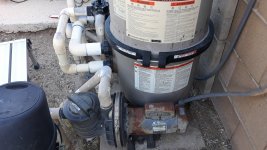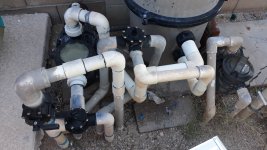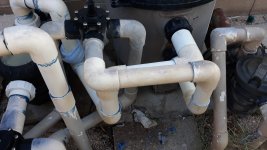New pool owner here. Old pool, old equipment.
We are experiencing air leak, on suction side, I think. The filter canister seems to bubble with incoming air when the pump is shut off, and has to be bled to get suction at vacuum port.
Also unable to separate skimmer and vacuum, which is a new development. Pool store suggested the first 3way valve diverter was bad.
All 3 valves have had diverters and o-rings replaced, as a first step elimination. But air still collects.
This seems to be a tangled mess, that I am hoping to replumb, without all of the elbows. It looks like previous owner has already added and subtracted at the valves, making use of adapters, so I'm thinking we will need to replace the valves, anyway. Yes?
Looking for advice that isn't super expensive.
Thanks in advance!


We are experiencing air leak, on suction side, I think. The filter canister seems to bubble with incoming air when the pump is shut off, and has to be bled to get suction at vacuum port.
Also unable to separate skimmer and vacuum, which is a new development. Pool store suggested the first 3way valve diverter was bad.
All 3 valves have had diverters and o-rings replaced, as a first step elimination. But air still collects.
This seems to be a tangled mess, that I am hoping to replumb, without all of the elbows. It looks like previous owner has already added and subtracted at the valves, making use of adapters, so I'm thinking we will need to replace the valves, anyway. Yes?
Looking for advice that isn't super expensive.
Thanks in advance!





 You're right, you have quite a challenge there, but certainly manageable. To recap, if the pump pot is showing signs of air under the clear lid while the pump is on, then it's a suction side air leak. If air goes into the pump pot and water moves around when the pump is turned off, then the air leak could be anywhere on that pad - suction or pressure side.
You're right, you have quite a challenge there, but certainly manageable. To recap, if the pump pot is showing signs of air under the clear lid while the pump is on, then it's a suction side air leak. If air goes into the pump pot and water moves around when the pump is turned off, then the air leak could be anywhere on that pad - suction or pressure side.